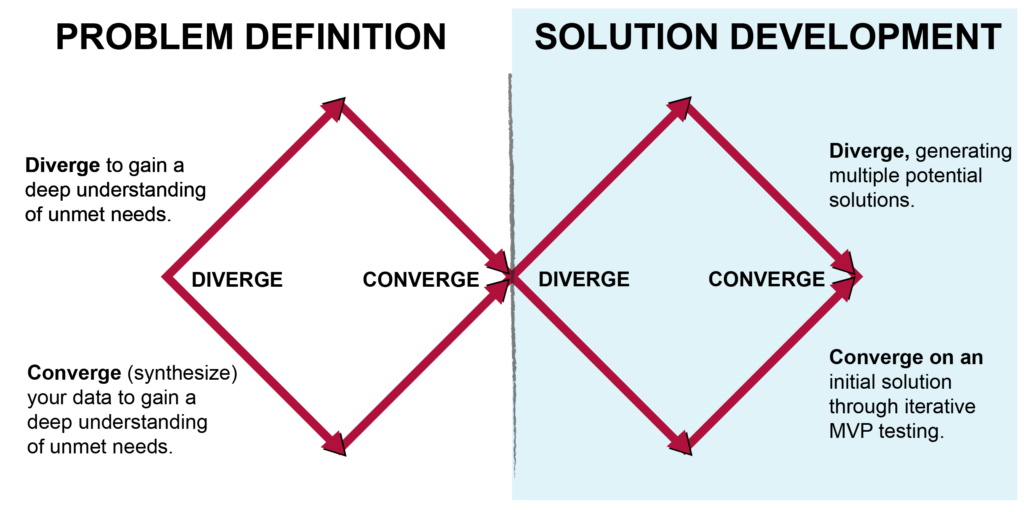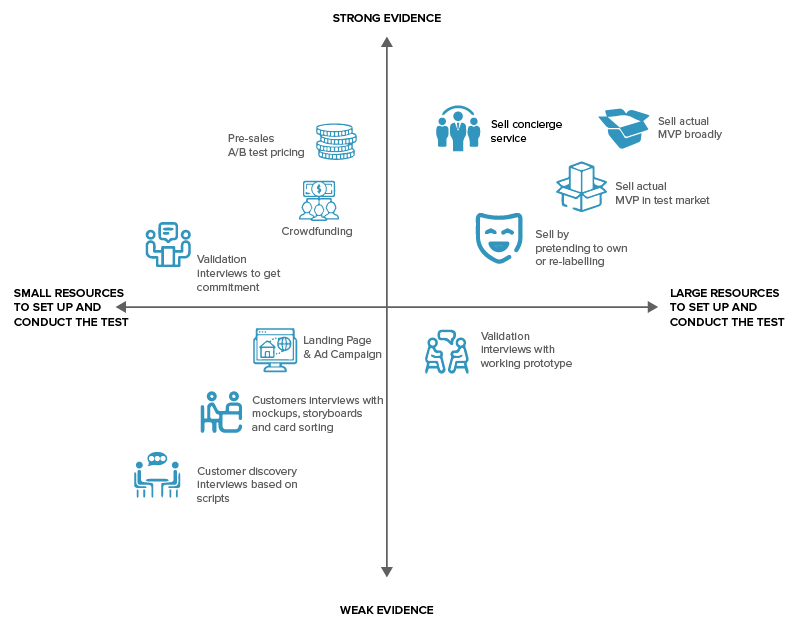Solution Development and MVP Testing
Harvard Business School strongly believes in the Double Diamond design process developed by the British Design Council. It emphasizes the need for divergent and convergent thinking in defining the problem and determining the solution. This is consistent with the Lean Startup methodology of Minimum Viable Product (MVP) development and testing, where problems and solutions are tested continuously on a particular target audience.
Fail fast is a prime tenet in Lean Startup methodology, and at its core, is very straight-forward. To help you succeed, and when resources are limited, learn to quickly rule out certain problems and solutions. This allows you to arrive at the core of the challenge faster. Please note that this is not always feasible when designing hardware, physical prototypes, or where commercializing breakthrough science is being tested — those ventures have unique pathways and constraints.

One of the most significant challenges that entrepreneurs have is that they believe, incorrectly so, that they must hire engineers or coders to build a fully functioning product to test how or if the customer will use their solution. MVP development is designed to test certain assumptions regarding the solution without using resources and coding.
Using tools such as landing pages, wireframes, videos, 3D prototypes, and even Google Docs or Excel spreadsheets will allow you to test your assumptions before making a major technology investment. In other words, you will do things (MVP design and tests) that you know will not scale effectively to answer specific questions. You use those learnings when you decide to commit resources to scalably designed solutions.

MVP tests take different forms and vary in their reliability, which is simply a part of the process. In early tests, you do not want to waste valuable resources (time, money, and human capital). An iterative process builds on what you have learned from previous tests. As you learn more about your true customer, the nuances of the problem or need, and the product you need to build that creates value, you build a greater level of confidence in your decisions to invest resources because you have validated your assumptions along your journey.
Types of MVP
Concierge
This is a personal approach to delivering your product or service. Everything you do is 1:1 and visible to the consumer. The entrepreneur is essentially providing all proposed front- and back-end functionality manually.
Wizard of Oz
As in the movie, where the wizard hides behind a curtain, your customer will only see the user interface and the results. However, everything you do in the backend is done “behind the curtain” and in a very manual manner. Sam Clemens and Fred Shilmover used this method when starting Insight Squared. They downloaded customers’ data from Salesforce, manipulated the data using Microsoft Excel, and then returned to the customer a nicely designed report of the analysis the customer needed.
Landing Pages and Smoke Tests
Launch a Google Ads campaign that brings people to a landing page where they are presented with a call to action. The landing page should describe the product or service, the unique value that it delivers (“secret sauce”), and include an element that requires them to act. This may be a button that allows users to sign-up to read more, join a mailing list, become a beta user, join a waitlist, or even provide a credit card to reserve a product.
Crowdfunding Techniques
This is the sell it before you build it approach. Kickstarter and Indiegogo are great places to test demand for your product. Customers sign-up to get first access to your product. The challenge is generating interest and demand for your product to ensure you hit your goals, receive funding, and deliver your product on time.
Explainer Videos
Dropbox used this approach extremely well to help potential customers understand their unique tool when cloud storage was not widely understood. Drew Houston, Founder and CEO, created a short video to explain the tool before it was even built for a large market.
Single Feature Product
As the name implies, you only develop the most important feature of your product. The feature should be the primary reason any customer will use your product. This is not the time for all the bells and whistles.
Simply put, this is one of the easiest MVP tests to deliver, but it requires having a reliable list of your target customers. The list might come from the landing page test you did, from a list of previous customers, or is a purchased list of target customers. Ryan Hoover of Product Hunt began his venture by emailing his idea to a list and received great feedback. He then knew he had some interest so he could build his product.
Tools & Instructions
We have collected some of our startup’s favorite tools for when they were launching their company and exploring ideas.
Wireframing
A Wireframe (wires/mockups) is a schematic or blueprint used to communicate to your developers and designers the structure of a software product, software application, or website. It can also be a great tool for testing your solution with your customers.
By showing your customers a mock-up, you can ask them if they understand the solution you are proposing and how helpful or not this solution may be to them. It is a great way to get product feedback before you even start coding. It is instrumental in getting feedback on a product feature and the user interface. Below are some of the more popular tools that founders have used to develop their wireframes.
Landing Pages
The clever use of a landing page allows you to promote information about your product to potential customers and evaluate their interest. However, beyond information, it supports testing customer action and follow-through. Including call(s) to action, such as newsletter signups or social media sharing, creates a data point to evaluate consumer interest. When appropriate, using your site to find early adopters and testing price is possible by supporting pre-purchases or deposits before product launch.
Website Builders
Websites are critical in today’s business environment. Choosing a platform depends on the type of venture you are launching, your team, and your technical knowledge. All-in-one website builders are the norm for early ventures and founders. While you may give up control on certain elements such as service choices or design, you gain an out-of-the-box solution that works and frequently integrates with other sales tools with minimal effort.
Low and No-Code Application Tools
Technical knowledge to build an application or the necessary funding to pay developers are frequently in short supply for many founders. However, with the rise of low- and no-code application tools, you can build an app that supports MVP testing, prototypes, and even useable first-launch products.
Digital Advertising
Advertising through a variety of outlets, particularly online, presents the opportunity for data collection and customer testing. Not only is it a marketing tool, but it aids in testing ideas with consumers. Unlike other sections, these advertising tools are robust, and therefore, complicated. For three of the major platforms, you can use these guides to get started:
Testing
Getting your product or service in front of real people is critical. There are services that support the recruitment of tester for both physical and digital products.
Presentation Design
At some point in your startup journey you will design a presentation or need graphic elements for your website, advertisements, etc. These tools skew towards being drag-and-drop friendly to support quick design with professional polish and appeal.
Resource Collections
There are a variety of information and tool collection sites available to aspiring entrepreneurs.
